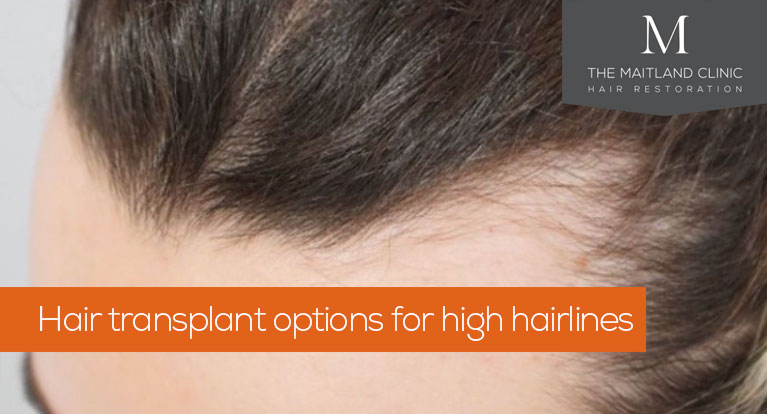Hair transplant options for high hairlines
16th October 2023

If you want to lower a high hairline or reduce the appearance of a large forehead, a hair transplant can be an effective option. Continue reading to learn more about the different approaches available and the key things to consider before undergoing a hairline transplant, and what options you have for a high forehead.
The main hair transplant options for high hairlines and foreheads are Follicular Unit Excision (FUE) and Follicular Unit Transplant (FUT), although bear in mind that surgery won’t be right for everyone. If you are a suitable candidate for a hair transplant, it’s important to create a realistic hairline that will look natural as you age.
What causes a high hairline?
The position and shape of the hairline (the area where the hair meets the forehead) depends on multiple factors. Some people are born with a naturally high hairline or a large forehead, whereas others may develop a high hairline as they get older. Either way, a high hairline can often be a source of concern for many people.
There are several reasons why you might have an excessively high hairline. These include:
- Genetics – Naturally high hairlines can often run in families and are inherited from one generation to the next.
- Ageing – Your hairline naturally matures as you get older, although this happens very gradually (you may not even notice it). A maturing hairline usually moves back no more than 1.5cm from the original hairline.
- Hormones – Hormonal changes can cause your hairline to recede. In men, for example, higher levels of the hormone dihydrotestosterone (DHT) have been shown to increase the risk of hair loss.
- A hair loss condition – Hair loss conditions such as male pattern baldness can result in a receding or excessively high hairline. In cases such as this, the hairline tends to recede quickly and usually by more than 1.5cm. It’s often accompanied by additional hair loss or thinning in other areas of the scalp.
- Tight hairstyles – Over time, restrictive hairstyles such as braids can cause the hairline to recede, particularly around the temples. However, traction alopecia can be reversible if treated early.
- Scarring alopecia (cicatricial alopecia) – This group of conditions can cause areas of irreversible hair loss. Scarring alopecias can be stabilised with medical treatments and so early detection is important in order to minimise the extent of hair loss. The conditions are often not suitable for hair transplant surgery due to the risk of recurrence. Types of scarring alopecias include lichen planopilaris and frontal fibrosis alopecia.
Can a hair transplant fix a high hairline?
A hair transplant can be a very effective way of lowering (and fixing) a high hairline, although surgery won’t be suitable for everyone. When planning to lower a high hairline, it’s important to aim for realistic results that will look natural for years to come. This is why we normally advise against creating an unusually low or unnaturally ‘youthful’ hairline.
We place a huge emphasis on using the finest possible hairs to transplant in order to create elegant, soft margins and a truly natural-looking hairline. The shape and character of the hairline design is carefully created by Dr Ball in order to blend seamlessly with your face shape and your existing hair. The design is also planned in order to take into consideration the long term future, any progressive hair loss and the inevitable ageing process.
Can you lower your hairline with a hair transplant?
Yes, it is possible to lower a hairline with a hair transplant, but we can do recommend a few options to consider first. For example, if your high hairline is due to a progressive condition like male pattern baldness, you may be advised to take hair loss medication to slow down the hair loss before undergoing a hair transplant. However, if this is not an option, we may recommend other non-surgical treatments such as platelet-rich plasma (PRP) or low-level laser therapy.
Once the hair loss has stabilised, Dr Ball will be able to ascertain whether you are a suitable candidate for a hair transplant and, if appropriate, plan and discuss surgery to lower your hairline. It’s important to note that we will only perform surgery if we believe there is a very good chance of achieving natural-looking results in the long term.
Hair transplant options for high foreheads and high hairlines
The two main types of hairline transplants we perform at The Maitland Clinic are known as Follicular Unit Excision (FUE) and Follicular Unit Transplant (FUT). Both techniques involve taking healthy hair follicles from a donor area of the scalp and transplanting them into tiny incisions in the recipient area (in this case, around the hairline). The main difference between the two methods is how the grafts are harvested.
FUE hair transplants for high hairlines/ foreheads
During an FUE hairline transplant, the donor area of the patient’s scalp is shaved and the follicular unit grafts are excised individually using a 0.8mm to 1mm ‘punch’. The grafts are taken from an area of the scalp where hairs are genetically programmed to grow for life (typically at the back and sides of the head).
The Maitland Clinic’s surgeon, Dr Edward Ball, then makes tiny slits in the recipient area of the scalp, carefully measured according to the size of your particular follicles. If your aim is to lower a high or receding hairline, these slits will be concentrated around the hairline and/or temples. Dr Ball pays extreme care and attention to the pattern, directions and density of the incisions to ensure the new hairline looks entirely natural and blends seamlessly with your native hair.
Finally, the grafts are placed into these slits by our highly skilled team of surgical assistants. An FUE hair transplant leaves a series of tiny dot scars in the donor area of the scalp, although these are barely visible to the naked eye unless hair is shaved very short or inspected very closely.
FUT hair transplants for high foreheads/hairlines
During an FUT hairline transplant, Dr Ball removes a strip of skin from the donor area of the scalp and places it under a high-powered microscope. The strip is then divided into tiny grafts of individual follicular units comprised of one to four hairs by our expert team of technicians. Once removed, the site of the donor strip is stitched closed and covered by the surrounding hair.
As with an FUE hair transplant, Dr Ball then makes tiny incisions in the recipient area of the scalp. He draws on his technical skill and exceptional artistry to create a natural-looking result that’s unique to each patient.
The stitches are removed around 10-14 days after surgery and the donor area heals to form a linear scar.
Lowering a high hairline – things to consider
If you’re thinking about having a hair transplant to lower a high hairline, you’ll need to consider a range of factors such as your age, face shape, the size of your head and the potential for future hair loss. (See: Important general principles to consider before proceeding with a hair transplant)
Remember, a hairline usually matures with age and restoring it to its original position or creating a youthful hairline could look unnatural later on. There’s also a risk that you won’t have an adequate supply of donor hair if you need to treat more areas of hair loss in the future.
It’s for this reason that Dr Ball tends to encourage mature hairline shapes in younger men who have a high chance of extensive hair loss in later life. A higher hairline will look more age-appropriate throughout your life and will also create a smaller treatment area, thus increasing the chances of having sufficient donor hair in the future.
Dr Ball has a particularly strong reputation for creating beautiful female hairline transplant results. He is renowned for the softness and naturalness of his hairline designs. The challenge of a limited donor hair supply is not such an issue in most female hairline transplants because women tend not to suffer from progressive hair loss to the extent that men do.
Occasionally, patients want to create a very low hairline because they think it will make their forehead look smaller. However, an unnaturally low hairline could actually draw more attention to your forehead. It’s also important to consider the shape of your face as a whole, not only the size of your forehead.
Achieving natural results
Planning the position of the hairline is a crucial aspect of any hair transplant process. That’s why Dr Ball and the team at The Maitland Clinic will work closely with you to design a hairline that looks natural. This will take into account a variety of factors such as your age, face shape, the pattern and extent of the hair loss and the characteristics of your existing hair.
We will only perform a hairline transplant on patients that we are confident will see a natural-looking result and one that will continue to look good in the long term. If we don’t believe you are a suitable candidate for a hair transplant, we will of course discuss other treatment options with you.
As well as great technical skill, creating natural-looking results also requires an understanding of the aesthetics of how hair grows and a large degree of artistry. With a background in plastic surgery and cosmetic medicine, Dr Ball is renowned for his attention to detail and personal approach. He takes time to develop a hair design that’s bespoke to you to create natural results that will serve you for a lifetime.
We have an excellent record of performing successful FUT and FUE hair transplant procedures for high hairlines in men, women and transgender patients. See examples and images in our Results gallery here. To arrange a consultation, call 02392 706122 or email enquiries@themaitlandclinic.com.










